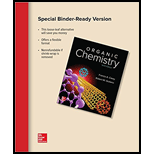
Interpretation:
The atoms that undergo changes in their oxidation states among the atoms in the given reaction are to be determined and the atoms that are oxidized or reduced are also to be determined.
Concept introduction:
Oxidation of carbon occurs when a less electronegative atom than carbon, from a bond with carbon, is replaced by a more electronegative atom.
Reduction of carbon occurs when a more electronegative atom than carbon, from a bond with carbon, is replaced by a less electronegative atom.
For carbon compound, when number of
For carbon compound, when number of
Decrease in the oxidation number from the reactant side to the product side for an element indicates the reduction process.
Increase in the oxidation number from the reactant side to the product side for an element indicates the oxidation process.
Want to see the full answer?
Check out a sample textbook solution
Chapter 2 Solutions
ORGANIC CHEMISTRY(LL)-W/ACCESS >CUSTOM<
- Indicate whether or not each of the following chemical reactions represents a combustion reaction. a. 4Fe + 3O2 2Fe2O3 b. C2H6O + 3O2 2CO2 + 3H2O c. 4NH3 + 3O2 2N2 + 6H2O d. C + CO2 2COarrow_forwardIndicate whether each of the following substances undergoes an oxidation number increase or decrease in a redox reaction. a. The oxidizing agent b. The reducing agent c. The substance undergoing oxidation d. The substance undergoing reductionarrow_forwardWrite the chemical formulas for the products formed when each of the following hydrocarbons undergoes complete combustion. a. CH4 b. C4H10 c. C4H6 d. C6H6arrow_forward
- This equation describes the production of tin(II) chloride: Sn(s) + 2HCl(g) ⟶ SnCl2(s) + H2(g)Is this a redox reaction? If so, provide a more specific name for the reaction if appropriate, and identify the oxidant and reductant.arrow_forwardWhat element is oxidized in the following chemical reaction?Cu + 2H2SO4 → CuSO4 + SO2 + 2H2Oarrow_forwardGiven the chemical equation: 4KO2 (s) + 2CO2 (g) > 2K2CO3 (s) + 3O2 (g) Indicate the oxidation number for each atom involved in the products: "K" , "O" in K2CO3 , "C" , "O" in O2arrow_forward
- What type of reaction is Na +H2O —>arrow_forwardWhat type of reaction is SeCI6 + O2 >SeO2 + 3CI2arrow_forwardUse oxidation numbers to show that the fermentation of glucose, C6H12O6 to carbon dioxide and ethanol, C2H5OH, is a redox reaction. The balanced reaction is: C6H12O6 2C2H5OH + 2CO2 C6H12O6 C2H5OH CO2 C = H= O=arrow_forward
 General, Organic, and Biological ChemistryChemistryISBN:9781285853918Author:H. Stephen StokerPublisher:Cengage Learning
General, Organic, and Biological ChemistryChemistryISBN:9781285853918Author:H. Stephen StokerPublisher:Cengage Learning Chemistry & Chemical ReactivityChemistryISBN:9781133949640Author:John C. Kotz, Paul M. Treichel, John Townsend, David TreichelPublisher:Cengage Learning
Chemistry & Chemical ReactivityChemistryISBN:9781133949640Author:John C. Kotz, Paul M. Treichel, John Townsend, David TreichelPublisher:Cengage Learning

